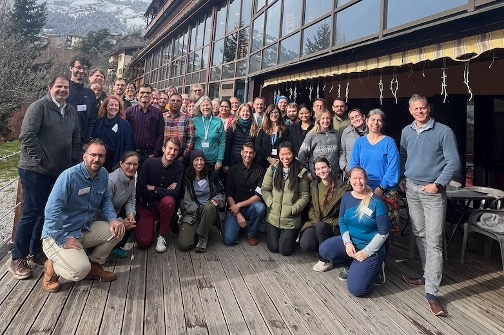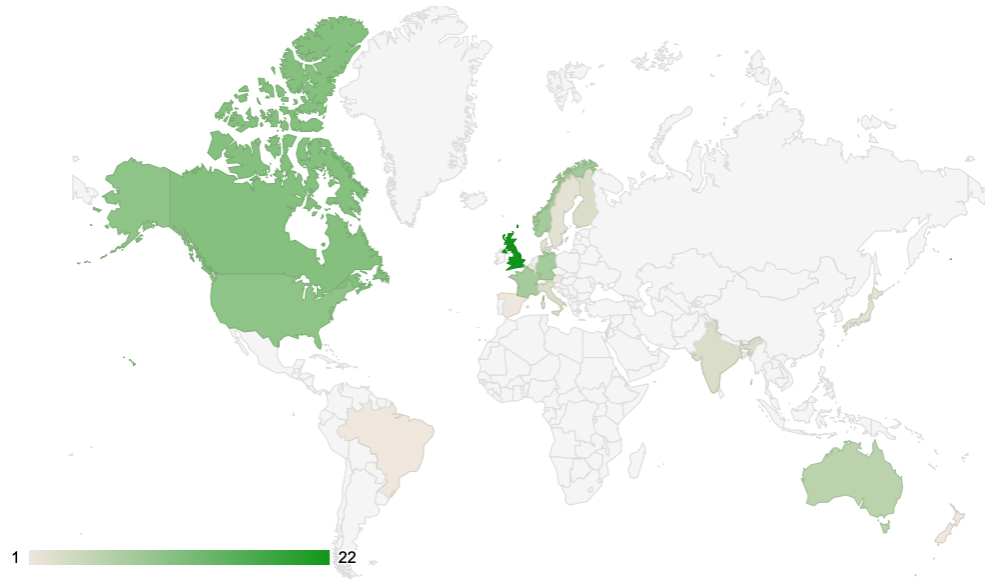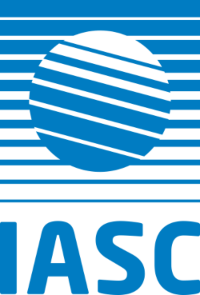 The International Polar Year 2032-33 planning workshop on “Chemical, biogeochemical, and physical drivers of the coupled polar atmosphere and climate” took place at the Centre Paul Langevin in Aussois, France from 17 to 22 November. The joint workshop was fully hybrid and co-organised by the international initiatives CATCH, PACES, BEPSII, ASPeCt and QUiesCENT. A total of 99 scientists and stakeholders (44 in person) from 21 countries came together (Figs.1,2). The group assembled core expertise in chemical, biogeochemical and physical processes in the Arctic and Antarctic with a research focus on the coupled atmosphere-ice-ocean system and links to climate change. The main workshop objectives were to i) present and discuss interdisciplinary ‘big picture’ science questions and challenges, and ii) jointly identify research priorities and implementation pathways for research activities in field, laboratory and modelling leading up to and during the 5th International Polar Year (IPY) 2032-2033. Planned workshop output includes a white paper to shape IPY32 funding calls, underpin grant applications, and influence the planning of polar research cruises, field campaigns and new long-term measurement capabilities.
The International Polar Year 2032-33 planning workshop on “Chemical, biogeochemical, and physical drivers of the coupled polar atmosphere and climate” took place at the Centre Paul Langevin in Aussois, France from 17 to 22 November. The joint workshop was fully hybrid and co-organised by the international initiatives CATCH, PACES, BEPSII, ASPeCt and QUiesCENT. A total of 99 scientists and stakeholders (44 in person) from 21 countries came together (Figs.1,2). The group assembled core expertise in chemical, biogeochemical and physical processes in the Arctic and Antarctic with a research focus on the coupled atmosphere-ice-ocean system and links to climate change. The main workshop objectives were to i) present and discuss interdisciplinary ‘big picture’ science questions and challenges, and ii) jointly identify research priorities and implementation pathways for research activities in field, laboratory and modelling leading up to and during the 5th International Polar Year (IPY) 2032-2033. Planned workshop output includes a white paper to shape IPY32 funding calls, underpin grant applications, and influence the planning of polar research cruises, field campaigns and new long-term measurement capabilities.
Participants were from across all career stages including 21 early career researchers (ECRs), who played active workshop roles as session chairs, rapporteurs, presenters and participants in discussions. The enthusiastic contributions by the ECRs (see caption of Fig.1) in shaping the workshop are particularly acknowledged due to the importance and value of outcomes from diverse perspectives.
The programme. On the first day plenary orientation sessions with short presentations set the scene regarding current research challenges and gaps for an audience from diverse science backgrounds. The SCAR executive director Dr. Chandrika Nath and IASC president Henry Burgess provided the high-level context of the next IPY in describing the aims and strategy from the perspectives of Arctic and Antarctic research; for further reading see also the 5th IPY homepage and 5th IPY concept note. This was followed by summaries of research priorities from CATCH, PACES, BEPSII, QUiesCENT and ASPeCt, who had previously consulted their own communities. These were complemented by a series of short talks on recent or ongoing research programs such as 4th IPY project POLARCAT, MOSAiC, AC3 or the H2020 projects CRiceS and PolarRES. A forward look was provided by presentations on, for example, the Tara Polar Station and Antarctica InSync. Breakout groups then discussed new science for the 5th IPY: which major scientific issues need to be tackled by international collaborative and cross-disciplinary efforts under the 5th IPY framework, considering both Poles; how the identified topics address the IPY concept note and its call to action; if there are possibilities for transdisciplinary research to address the identified topics, including co-development of activities with indigenous or local communities; and finally, how outcomes provide new knowledge for international policy agreements.
 On the second day keynote talks on interdisciplinary ‘big picture science’ at the poles followed by discussion provided a larger view on how topics are connected and how processes in the coupled ocean-ice-atmosphere system are linked and potentially driving climate feedback loops. Topics included polar sea ice loss, the role of sea ice in polar biogeochemistry and ecosystems, chemical air-snow exchange, short-lived climate forcers, cloud aerosol interactions, climate interventions and policy and socially relevant research in the Arctic. The participants then broke up into smaller groups to rotate through a series of World Café sessions discussing each a specific topic regarding the implementation of new science for the 5th IPY. These topics were: research cruises, modelling experiments, new observation technologies, laboratory experiments, aircraft campaigns and remote sensing, ground observations (short/long term; community involvement).
On the second day keynote talks on interdisciplinary ‘big picture science’ at the poles followed by discussion provided a larger view on how topics are connected and how processes in the coupled ocean-ice-atmosphere system are linked and potentially driving climate feedback loops. Topics included polar sea ice loss, the role of sea ice in polar biogeochemistry and ecosystems, chemical air-snow exchange, short-lived climate forcers, cloud aerosol interactions, climate interventions and policy and socially relevant research in the Arctic. The participants then broke up into smaller groups to rotate through a series of World Café sessions discussing each a specific topic regarding the implementation of new science for the 5th IPY. These topics were: research cruises, modelling experiments, new observation technologies, laboratory experiments, aircraft campaigns and remote sensing, ground observations (short/long term; community involvement).
The third day started off with a session on Indigenous and community collaboration with case studies from the Canadian Arctic, Greenland and New Zealand, and a session on impactful science communication with a strategic outlook on the 5th IPY. Brainstorming sessions then followed up on the discussions from the previous days around new science and implementation pathways to define priority research areas and list main research challenges and tools.
The fourth day commenced with talks reminding the group of some of the target stakeholders for planned IPY activities, including the International Ice Charting WG (IICWG) and Global Cryosphere Watch (CWG)/ WMO. Breakout groups for each of four identified priority research areas continued to discuss and were tasked to produce overview figures for potential use in the planned white paper.
The fifth day concluded the workshop with a public stakeholder session, a workshop synthesis presentation, a talk on perspectives from Climate and Cryosphere (CliC), a core project of the World Climate Research Program, and the final discussion.
The hybrid experience. The workshop was fully hybrid, and on-site participants were encouraged to log into Zoom to level the playing field with the online participants. Online poster sessions in Gathertown allowed for individual science presentations and further discussions.
Workshop feedback. Participants provided feedback in a survey, which was mostly positive, in particular regarding presentation topical range and quality, space provided for discussions, hybrid management, networking and building an IPY community.
Conclusions and next steps. This group with core expertise in chemical, biogeochemical and physical sciences of the polar atmosphere, ice and ocean made a first step in building a conceptual framework for a 5th IPY research program, which will be fed into the wider IPY process. The four priority research areas identified were: 1. The Water Cycle; 2. Atmospheric Composition; 3. Biogeochemistry and Ecosystems; and 4. The Energy Budget. These research areas rest on five supporting pillars consisting of 1. field observations, 2. laboratory experiments, 3. data management, 4. numerical modelling, and 5. community knowledge and engagement. Together these will enable progress to achieve the larger societal objectives of Global Weather and Climate Understanding, Polar ecosystem health, Global Security and Resilience, and Community Health and Well-Being. A detailed synthesis and overview concept will be published as a white paper in 2025.
It was recognised that rather than duplicating effort this group will liaise with other existing groups and programmes. Furthermore, collaboration and collaborative projects will already start now in preparation of the 5th IPY. To do this the workshop URL will be used as a digital hub with the video recordings of keynotes and short presentations publicly available, a participant list, and announcements of future meetings and events via the workshop email list. This group remains open, and anyone interested is welcome to join by emailing ipy2032workshop@univ-grenoble-alpes.fr.
Acknowledgements. We are very thankful for generous financial support from IASC, SOLAS, IGAC, CATCH, CliC and CNRS, which provided full or partial funding to participants, including ECRs and invited speakers, enabling their workshop participation. We also thank Emmanuelle Gennai at IGE/Grenoble and the CNRS finance team for their administrative support, as well as Thorsten Bartels-Rausch and the Paul-Scherrer-Institute/Switzerland for providing the platform to host the workshop web page.
Highlights
-
1. The event succeeded in fostering the formation of a new interdisciplinary and diverse science community with core expertise in chemical, biogeochemical and physical sciences of the polar atmosphere, ice and ocean to start planning activities of the 5th International Polar Year.
2. The group made a first step in building a conceptual framework for a 5th IPY research program, which will be fed into the wider IPY process. The four priority research areas identified were: 1. The Water Cycle; 2. Atmospheric Composition; 3. Biogeochemistry and Ecosystems; and 4. The Energy Budget. These research areas rest on five supporting pillars consisting of 1. field observations, 2. laboratory experiments, 3. data management, 4. numerical modelling, and 5. community knowledge and engagement. Together these will enable progress to achieve the larger societal objectives of Global Weather and Climate Understanding, Polar ecosystem health, Global Security and Resilience, and Community Health and Well-Being.
3. The workshop URL with video recordings of the presentations, participant list and announcements of future events will be used as a digital hub to foster collaborations already now in preparation of the 5th IPY. This group remains open, and anyone interested is very welcome to join by emailing ipy2032workshop@univ-grenoble-alpes.fr.
Picture, top left: In-person participants of the 2024 IPY5 planning workshop in Aussois, France. Photo courtesy of the organisers.
Picture, middle-right: In total 99 participants (44 in-person) from 21 countries in both hemispheres participated in the IPY5 workshop.
More info: https://indico.psi.ch/event/15591/
Date and Location
17 – 22 November 2024 | Aussois, Alps/ France
IASC Working Groups funding the project
- Atmosphere WG
- Cryosphere WG
- Marine WG
Project Lead
Markus Frey British Antarctic Survey, UK
Year funded by IASC
2024
